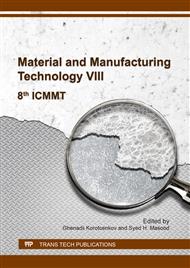[1]
H. Gu, Materials & Design, 30, 4 (2009).
Google Scholar
[2]
C.B. Lawrence, C.E. Bakis, V.L. Brown, S.H. Rizkalla, T.C. Triantafillou, J.F. Davalos, E. Cosenza, J.J. Lesko, and A. Machida, Journal of Composites for Construction, 6, 2 (2002).
DOI: 10.1061/(asce)1090-0268(2002)6:2(73)
Google Scholar
[3]
Z.K. Awad, T. Aravinthan, and Y. Zhuge, Construction and Building Materials, 37, (2012).
Google Scholar
[4]
R. Burgueño, M.J. Quagliata, G.M. Mehta, A.K. Mohanty, M. Misra, and L.T. Drzal, Journal of Polymers and the Environment, 13, 2 (2005).
Google Scholar
[5]
Y. Gao, J. Chen, Z. Zhang, and D. Fox, Composite Structures, 96, (2013).
Google Scholar
[6]
M. Chieruzzi, A. Miliozzi, and J.M. Kenny, Composites Part A: Applied Science and Manufacturing, 45, (2013).
Google Scholar
[7]
M. George, G.E. Kochimoolayil, and H. Jayadas Narakathra, Journal of Applied Polymer Science, 133, 13 (2016).
Google Scholar
[8]
D. Romanzini, A.A. Silva, B.G. Soares, A.J. Zattera, and S.C. Amico, Journal of Composite Materials, 51, 2 (2016).
Google Scholar
[9]
D. Romanzini, F. Cuttica, A. Frache, A.J. Zattera, and S.C. Amico, Polymer Composites, (2015).
Google Scholar
[10]
P. Jawahar, R. Gnanamoorthy, and M. Balasubramanian, Wear, 261, 7–8 (2006).
Google Scholar
[11]
X. Yu, C. Wei, D. Xu, C. Lu, J. Yu, and S. Lu, Journal of Applied Polymer Science, 103, 6 (2007).
Google Scholar
[12]
Kusmono and Z. Arifin Mohd Ishak, International Journal of Polymer Science, 2013, (2013).
Google Scholar
[13]
Y.J.V. Ruban, S.G. Mon, and D.V. Roy, Polymer Science Series A, 56, 6 (2014).
Google Scholar
[14]
S. Şen, Polymer Composites, 31, 3 (2010).
Google Scholar
[15]
M. Ahmadi, M.R. Moghbeli, and M.M. Shokrieh, Iranian Polymer Journal, 21, 12 (2012).
Google Scholar
[16]
N. Rajini, J.T. Winowlin Jappes, C. Rajakarunakaran, and I. Siva, Nano Hybrids, 2, (2012).
DOI: 10.4028/www.scientific.net/nh.2.87
Google Scholar
[17]
K. Kanny and T.P. Mohan, Composites Part B: Engineering, 58, (2014).
Google Scholar
[18]
K. Dean, L. Yu, and D.Y. Wu, Composites Science and Technology, 67, 3–4 (2007).
Google Scholar
[19]
A. Rivera-Gonzaga, A. Sanchez-Solis, G. Sanchez-Olivares, F. Calderas, and O. Manero, Journal of Polymer Engineering, 32, 1 (2012).
DOI: 10.1515/polyeng-2011-0118
Google Scholar
[20]
N. Sombatsompop, K. Chaochanchaikul, C. Phromchirasuk, and S. Thongsang, Polymer International, 52, 12 (2003).
Google Scholar
[21]
E.M.S. Sanchez, C.A.C. Zavaglia, and M.I. Felisberti, Polymer, 41, 2 (2000).
Google Scholar


